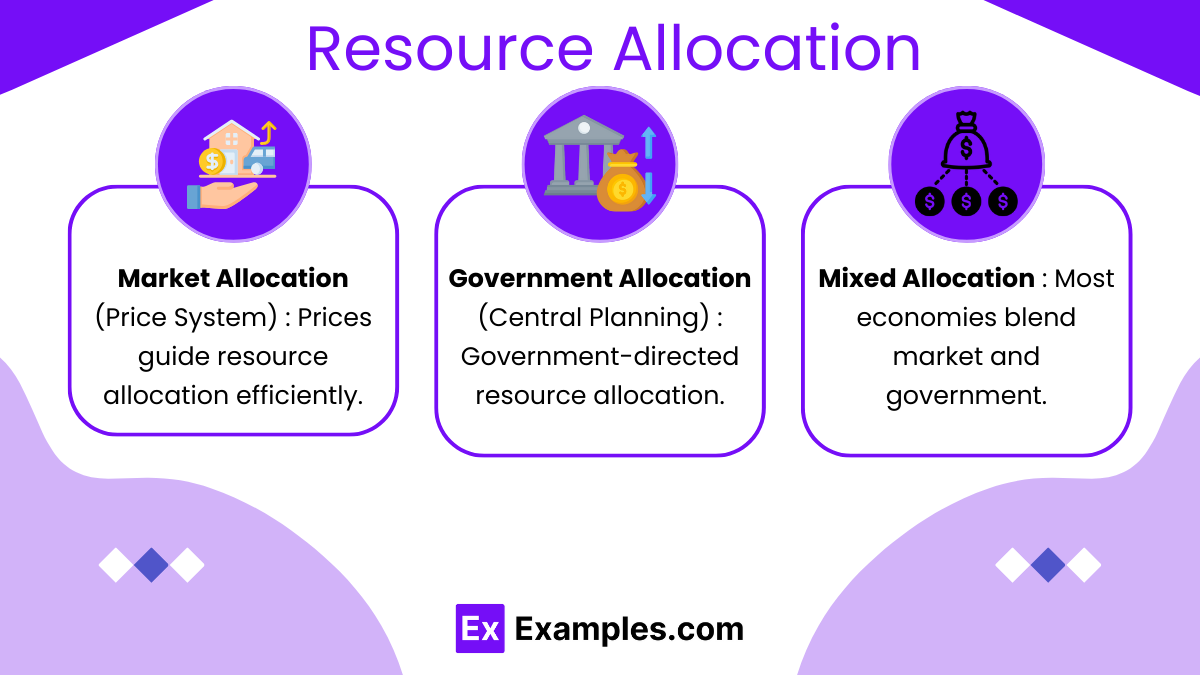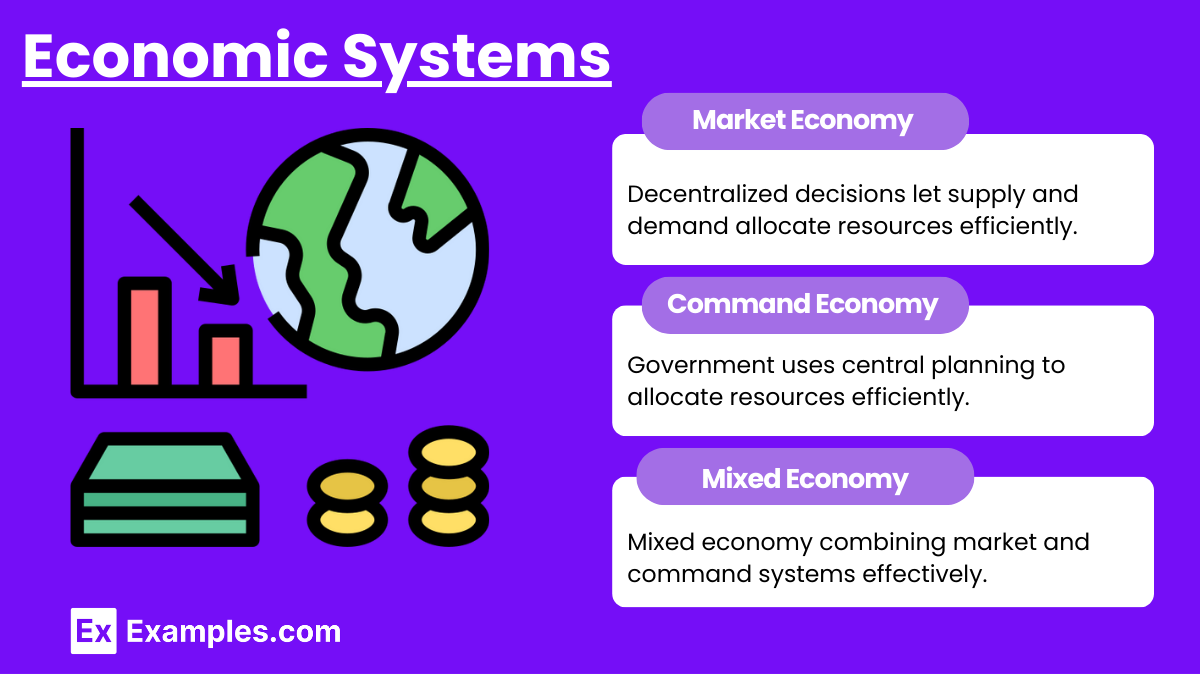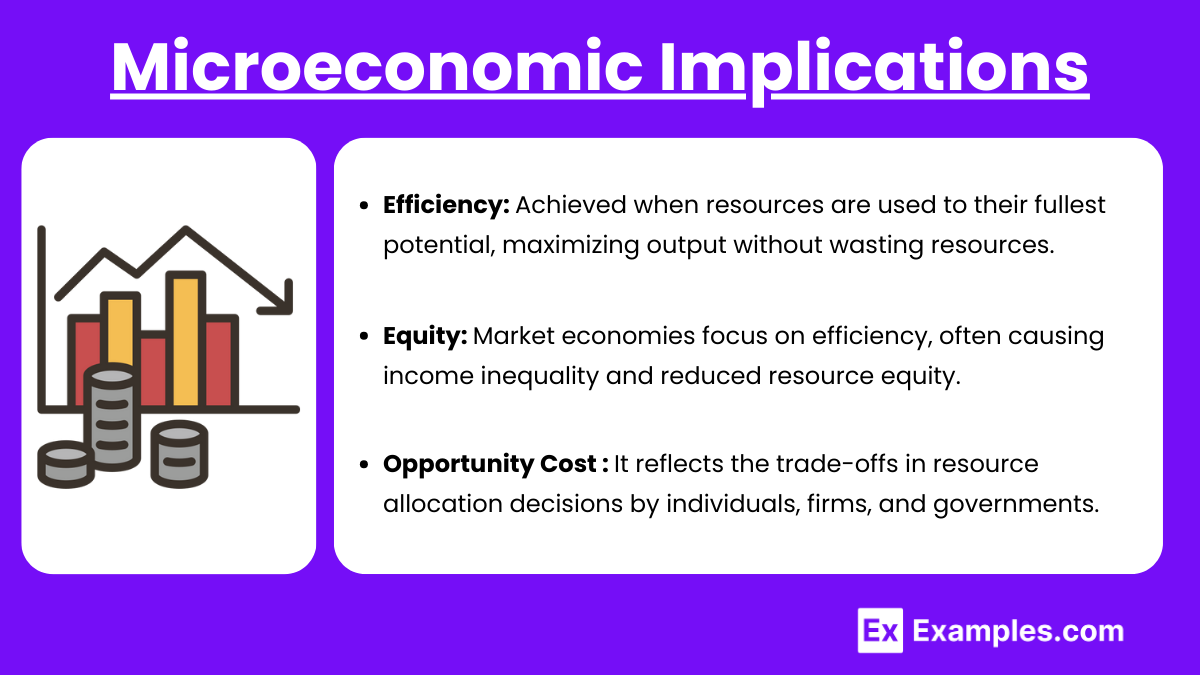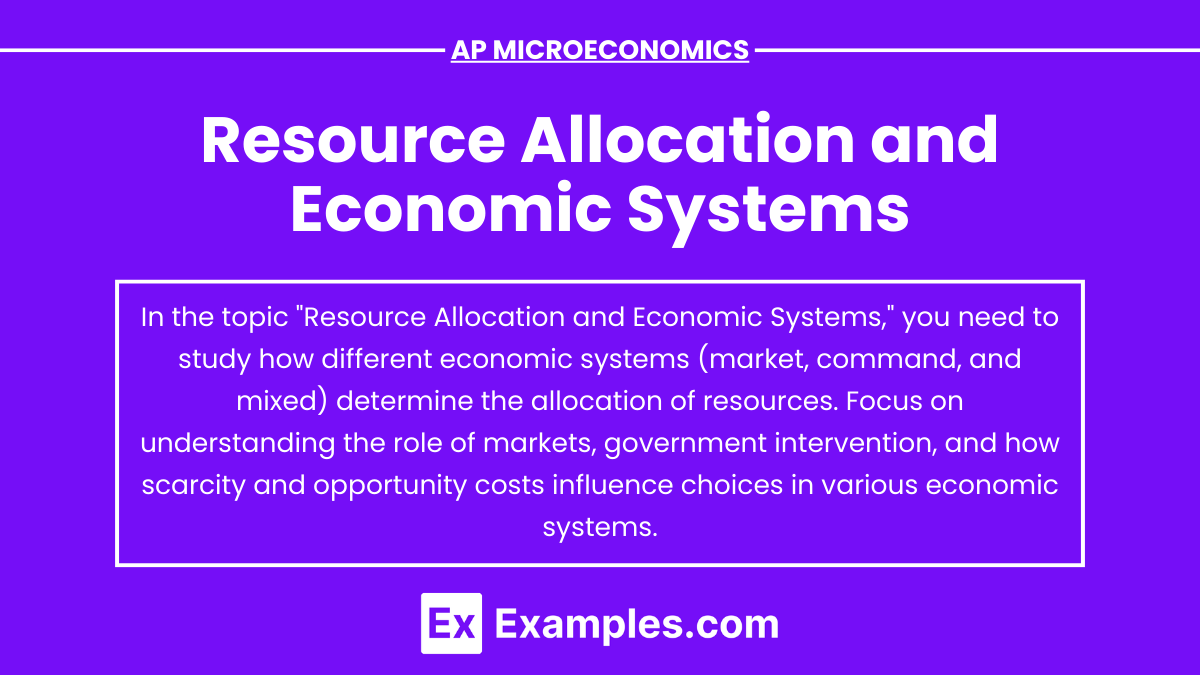In AP Microeconomics, Resource Allocation and Economic Systems focus on how limited resources are distributed to meet the needs and wants of individuals and firms within various economic systems. This topic examines the mechanisms used to allocate scarce resources efficiently, such as market forces, government intervention, or a combination of both. It also explores how different economic systems—market, command, and mixed—affect decisions regarding production, distribution, and consumption, highlighting trade-offs between efficiency and equity in resource distribution. Understanding these principles is key to mastering microeconomic theory.
Learning Objectives
When studying Resource Allocation and Economic Systems for AP Microeconomics, you should learn how resources are distributed through market forces, government intervention, and mixed economies. Focus on understanding how scarcity drives the need for efficient resource use and the trade-offs involved in economic decision-making. Study the advantages and disadvantages of different economic systems, including market economies, command economies, and mixed economies, as well as the concepts of efficiency, equity, and opportunity cost in determining resource allocation.
Resource Allocation

Resource allocation refers to how a society decides to distribute its limited resources, such as labor, capital, land, and technology, to produce goods and services. The core challenge of resource allocation in microeconomics is the concept of scarcity: there are limited resources available to satisfy unlimited human desires. Key mechanisms include:
- Market Allocation (Price System): In a market economy, prices serve as signals for the allocation of resources. When demand for a good rises, its price increases, signaling producers to allocate more resources toward producing that good. In this system, consumer choice and producer competition drive efficiency.
- Government Allocation (Central Planning): In a command economy, resource allocation is directed by the government. The government decides what, how, and for whom goods and services are produced. While it can be efficient in ensuring equitable distribution, it often lacks the flexibility and incentives for innovation found in market systems.
- Mixed Allocation: Most economies are mixed economies, incorporating elements of both market-based and government-controlled resource allocation. The government may regulate or intervene in certain industries (e.g., healthcare, education), while others are left to market forces.
Economic Systems

Economic systems define how a society organizes its economy to address the three fundamental questions: What to produce? How to produce? For whom to produce? The three primary types of economic systems include:
- Market Economy (Capitalism): Decisions are decentralized, and the forces of supply and demand determine resource allocation. Private property and competition are key features. Efficiency is achieved through voluntary exchange, but market failures (e.g., externalities, public goods) may require government intervention.
- Command Economy (Socialism/Communism): The government controls and makes decisions about resource allocation. Central planning is used to distribute goods and services. This system aims for equity but can result in inefficiencies due to a lack of incentives for innovation and productivity.
- Mixed Economy: Combines elements of both market and command systems. Most modern economies, such as the United States, fall into this category. Private markets operate alongside government interventions to correct market failures, provide public goods, and ensure equity.
Microeconomic Implications

In microeconomics, resource allocation is closely tied to concepts like:
- Efficiency: Achieved when resources are used to their fullest potential, maximizing output without wasting resources. Perfect competition is an idealized market structure that leads to allocative and productive efficiency.
- Equity: The fair distribution of resources. Market economies prioritize efficiency but may sacrifice equity, leading to income inequality. Government interventions like welfare and progressive taxation aim to redistribute wealth for greater equity.
- Opportunity Cost: A critical concept in resource allocation, it reflects the trade-offs that individuals, firms, and governments face when choosing how to use resources. The opportunity cost of producing more of one good is the loss of producing another.
Examples
Example 1: Market Economy and Pricing of Goods
In a free market economy like the U.S., the prices of goods and services are determined by supply and demand. For example, if the demand for electric vehicles increases, the price of these vehicles will rise, signaling manufacturers to allocate more resources toward producing them. Consumers’ willingness to pay higher prices for cleaner energy solutions encourages firms to invest in technologies like lithium-ion batteries and autonomous driving systems, driving efficiency through competition.
Example 2: Government Allocation of Healthcare Resources
In a command economy, the government directly allocates resources. For example, in countries with nationalized healthcare systems, such as the United Kingdom’s National Health Service (NHS), the government determines how many hospitals to build, how many doctors to hire, and which treatments will be available. Resource allocation is based on the collective needs of the population rather than market demand, aiming for equitable access to healthcare, though this may lead to inefficiencies like long waiting times.
Example 3: Mixed Economy and Education
In most countries, education is an example of a mixed system. While there are private schools where market forces determine pricing and availability, public education is provided by the government to ensure equitable access. The allocation of resources like teachers, school facilities, and technology in public schools is driven by government funding and policies, while private schools respond to market demand, balancing both efficiency and equity in resource distribution.
Example 4: Command Economy and Agricultural Production
In a centrally planned economy, the government decides what crops to grow and how much to produce. For example, in the Soviet Union, the government allocated resources like land, labor, and machinery for the production of wheat and other staple crops. While the goal was to ensure enough food for the population, inefficiencies in planning often led to misallocation of resources, resulting in shortages or surpluses.
Example 5: Market Failure and Government Intervention in Pollution Control
In a market economy, firms may overproduce goods that generate pollution because they do not bear the full social cost of the environmental damage. This is an example of a market failure. To correct this, governments may intervene by imposing pollution taxes or cap-and-trade systems. By putting a price on pollution, the government shifts resource allocation, incentivizing firms to reduce emissions and invest in cleaner technologies, addressing both efficiency and externalities in resource allocation.
Multiple Choice Questions
Question 1
In a market economy, which of the following primarily determines how resources are allocated?
A) Government regulation
B) Central planning committee
C) Prices of goods and services
D) Consumer preferences alone
Correct Answer: C) Prices of goods and services
Explanation: In a market economy, prices serve as signals for both consumers and producers. When demand for a product increases, the price usually rises, incentivizing producers to allocate more resources toward producing that good. Conversely, when demand falls, prices decrease, reducing production. While consumer preferences influence demand, it’s the price system that acts as the primary mechanism for resource allocation by coordinating the decisions of buyers and sellers.
Question 2
Which of the following is a characteristic of a command economy?
A) Resource allocation is driven by the decisions of individual firms and households.
B) The government makes all key economic decisions, including what to produce and how to distribute goods.
C) Prices are determined entirely by supply and demand without government intervention.
D) Economic efficiency is always maximized due to the lack of government involvement.
Correct Answer: B) The government makes all key economic decisions, including what to produce and how to distribute goods.
Explanation: In a command economy, the government plays a central role in resource allocation. It decides what goods and services should be produced, how they should be produced, and how they should be distributed across society. This is the opposite of a market economy, where such decisions are made through the price system and market forces. Command economies prioritize government control over economic activity, which can sometimes lead to inefficiencies due to the lack of market signals like prices.
Question 3
Which of the following is a likely result of a market economy compared to a command economy?
A) Greater resource allocation to industries with high consumer demand
B) Higher levels of government control over individual economic choices
C) Equal distribution of resources regardless of productivity or market demand
D) No opportunity cost in production decisions
Correct Answer: A) Greater resource allocation to industries with high consumer demand
Explanation: In a market economy, resources are allocated based on consumer demand and the price system. When consumers demand more of a good, producers respond by allocating more resources to the production of that good in order to maximize profit. This is in contrast to a command economy, where the government decides resource allocation, often without responding to changes in consumer preferences. Market economies are more likely to adjust to shifts in demand, whereas command economies might allocate resources inefficiently if central planners misjudge needs.


